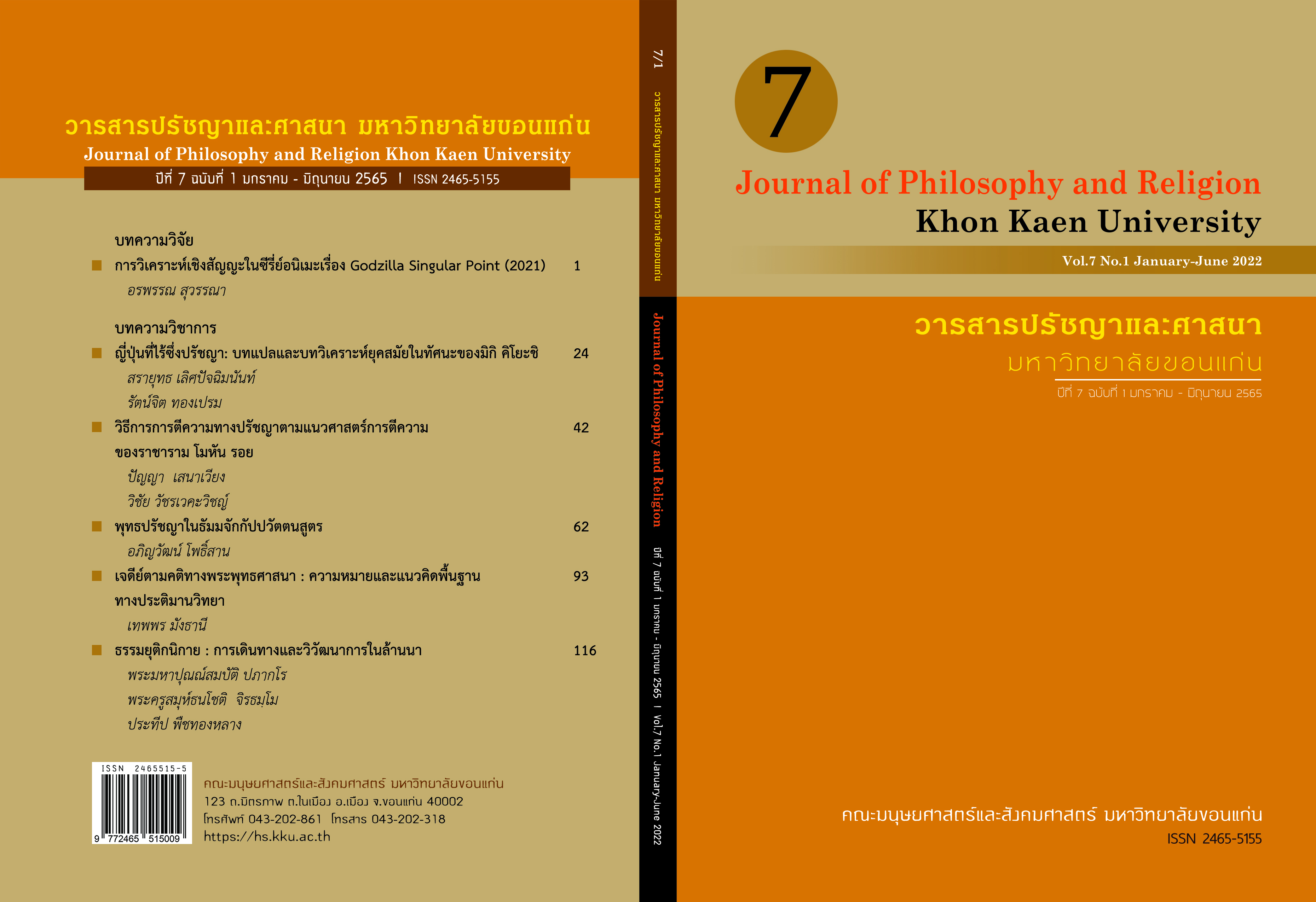พุทธปรัชญาในธัมมจักกัปปวัตตนสูตร Buddhist Philosophy in Dhammacakkappavattanasutra
Main Article Content
Abstract
บทคัดย่อ
บทความวิชาการนี้ เขียนขึ้นเพื่อแสดงพุทธปรัชญาในธัมมจักกัปปวัตตนสูตร โดยใช้วิธีการวิเคราะห์และตีความประเด็นและความคิดที่เกี่ยวข้องในบริบทช่วงก่อนและหลังการแสดงธัมมจักกัปปวัตตนสูตรของพระพุทธเจ้า โดยนำมาเชื่อมโยงกับการมีความหมาย วิธีการ แนวคิด และลักษณะความรู้ทางพุทธปรัชญา ที่วิเคราะห์ถอดความออกมาจากนัยของธัมมจักกัปปวัตตนสูตร แล้วเขียนนำเสนอเป็นบทความเพื่อสะท้อนให้เห็นกระบวนการทางปรัชญาของพระพุทธเจ้า
ผลการศึกษาพบว่า พุทธปรัชญาในธัมมจักกัปปวัตตนสูตร มีลักษณะเป็นกระบวนการทางปรัชญา โดยมีวิธีการ แนวคิด และลักษณะความรู้ในทางพุทธปรัชญา วิธีการทางพุทธปรัชญาเริ่มจากการนำประสบการณ์เดิมของพระพุทธเจ้าในการใช้ชีวิตฆราวาสที่สะดวกสบายและมองเห็นโลกสวยงาม 29 ปี และการหนีออกจากพระราชวังไปบวชบำเพ็ญทุกกรกิริยาโดยทรมานร่างกายให้ลำบากเพื่อค้นหาความจริงเป็นเป้าหมายถึง 6 ปี มาเสนอเป็นบทตั้งแก่ปัญจวัคคีย์ก่อน แล้วกล่าววิพากษ์วิจารณ์แนวคิดและแนวปฏิบัติสุดโต่งแบบกามสุขัลลิกานุโยคและอัตตกิลมถานุโยคทั้ง 2 ให้เห็นว่า ไม่ควรข้องแวะ เพราะมีข้อบกพร่องหรือไม่ดีหลายประการ จากนั้นจึงนำเสนอทางสายกลาง (มัชฌิมาปฏิปทา) คือ มรรคมีองค์ 8 ว่าเป็นแนวคิดและแนวปฏิบัติที่ดีกว่า เพราะทำให้เกิดดวงตาปัญญาและเกิดองค์ความรู้ในอริยสัจ 4 ได้ ทำให้ผู้ปฏิบัติตามถึงซึ่งความสงบแห่งกิเลส ความรู้ยิ่งอริยสัจ 4 ความตรัสรู้อริยสัจ 4 และการบรรลุถึงนิพพานได้ แนวคิดทางพุทธปรัชญาในธัมมจักกัปปวัตตนสูตร ว่าด้วยอริยสัจ 4 ที่พระพุทธเจ้าได้ตรัสรู้แล้ว และเป็นความรู้ที่ทำให้โกณฑัญญะ หนึ่งในปัญจวัคคีย์ ผู้สดับความจริงที่ตรัสแสดงแล้วนั้น ได้ดวงตาเห็นธรรมจนเป็นพระโสดาบัน จัดเป็นความรู้จริงที่บรรลุด้วยวิปัสสนาญาณ อันเป็นการรู้เห็นตามเป็นจริง ที่มีลักษณะวนครบ 3 รอบแห่ง สัจญาณ กิจญาณ กตญาณ ตามกิจในอริยสัจ 4 ข้อๆ ละ 3 รอบ จนมีอาการ 12 รอบ (3 x 4 = 12) และความรู้ทางพุทธปรัชญาในธัมมจักกัปปวัตตนสูตร ก็มีลักษณะเป็นแบบ “รู้เพื่อปฏิบัติ” หรือ “รู้เพื่อบอกสอนคนอื่นให้ปฏิบัติตาม” ในการนำมาแสดงต่อคนอื่น จนโกณฑัญญะรู้เห็นเป็นพยานของการรู้ความจริงอันประเสริฐที่พระพุทธเจ้าได้ตรัสรู้แล้วนั้นได้
คำสำคัญ : พุทธปรัชญา, ธัมมจักกัปปวัตตนสูตร
Abstract
This scholarly article demonstrates the Buddhist philosophy in the Dhammacakkappavattanasutra by studying and understanding the key issues and ideas before and after the Buddha’s Dhammacakkappavattanasutra teaching. They are associated with the meaning, techniques, concepts, and characteristics of knowledge in Buddhist philosophy, which are examined and transcribed from the implications of the Dhammacakkappavattanasutra, and then an article is created to reflect on the Buddha’s approach in Buddhist philosophy. Buddhist philosophy in the Dhammacakkappavattanasutra is classified as a philosophical process having method, concept, and characteristic of knowledge, according to the findings of the study. The method of Buddhist philosophy began with establishing as a lemma for the Pañcavaccīyas (the group of five monks) the Buddha’s original experiences in living a comfortable secular life and seeing the beautiful world for 29 years, and in escaping the royal palace to become a monk to perform every action by torturing the body to discover the truth for 6 years. Then He criticized the two extreme beliefs and practices, Kãmasukhallikãnuyoga (Sensual Indulgence) and Attakilamathãnuyoga (Self-Mortification), in order to demonstrate that they should be opposed due to their many defects or negative characteristics. He then introduced the intermediate way or Majjhimãpaṭipadã, also known as the Eightfold Path, as a superior concept and practice. Because it grants eyes of insight and builds a body of knowledge in the Four Noble Truths, enlightenment of the Four Noble Truths, and Nibbãna. The concept of Buddhist philosophy in Dhammacakkappavattanasutra is the Four Noble Truths that the Lord Buddha had already enlightened, as well as the understanding that Koṇḍañña, one of the Pañcavaccīyas, had the same vision of the Dhamma as Sotãpanna (Stream-enterer). These Truths are categorized as real knowledge attained by Vipassanãñãṇa, which is real perception and insight with the characteristics of 3 complete cycles of 3 Ñãṇadassanas, namely Saccañãṇa, Kiccañãṇa, Katañãṇa, following the Kiccas (functions) in the Four Noble Truths, 3 times each, until there are 12 cycles of Ãkãras (symthoms) (3 x 4 = 12). Then, the knowledge of Buddhist philosophy in Dhammacakkappavattanasutra is comparable to the style of “knowing to act” or “knowing to teach others to follow” in bringing to show others to know according to until Koṇḍañña, one of the Pañcavaccīyas, knows and sees it as evidence of knowing the Four Noble Truths that the Lord Buddha had already enlightened.
Keywords : Buddhist Philosophy, Dhammacakkappavattanasutra


